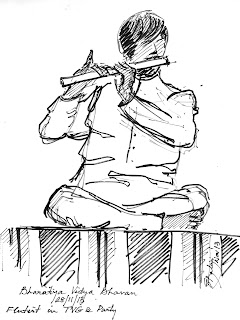Tamilnadu, in southern India, currently has 38 districts. Between January 2015 and March 2020, when the covid pandemic changed the way we lived, my wife and I visited most of these districts as part of a heritage tour group. We made around nineteen or twenty such trips during this time. The trips came to a halt during the pandemic and resumed once things came back to normal. My wife has resumed travelling but I have not.
I am sharing some of the locations and higlights of these trips that I recorded through sketches.
Sri Satyagirinatha Perumal Koil, Thirumeiyam
This is a pen and ink sketch done on location during a very enjoyable heritage tour of the Chettinad region. A very bitter war in the 13th century AD between Shaivites and Vaishnavites resulted in a neighbouring Hoysala king having to arbitrate and get them to partition a temple, and extensively relocate to different parts of the settlement based on the sect that they belonged to, thus resolving their differences. This is one of the two resultant temples. Both temples have identical stone inscriptions recording the agreement that was reached.
Thirumukkoodal
This is a place close to Kancheepuram which, as far back as over 1000 years ago, was functioning as a very well run medical institution. The stone walls of this builiding carry detailed descriptions of how this centre functioned. The colours in my sketch are different from what is actually there on location. I was limited by the colours available in my mini palette box.
Mamandur Jain Caves
These are Jain temple caves located near Kancheepuram, about 90 kms from Chennai. The caves are located atop a small hill, but I took one look at the height that I would need to climb to get to the caves, and decided to stay back some distance from the hillock. By the time the rest of the group went up and returned I managed a couple of pencil/pen sketches., this being one of them. I turned this into a watercolour sketch in my Khadi watercolour paper sketchbook on my return to Chennai.
Madurai Meenakshi Gopuram (Temple Tower)
We visited this famous temple during a tour of Madurai, Sivaganga, and a couple of other places. The temple is very popular and therefore attracts large crowds. Visitors and devotees are urged to keep moving so that all get a chance to view the deity. I spent about 15 minuted on this sketch on location and in that time I got the framework for the composition in place. I completed the sketch after returning to Chennai.
On these heritage tours it is very difficult to name on location as the highlight of the trip, since we visit so many wonderul places each time. But this was particularly memorable for many reasons. Shembaga Vilasam is located in the Pollachi Taluk of Coimbatore District, with the western ghats serving as a picturesque backdrop. The family who hosted us are a part of the Kalingaraya family who have been local chieftains for around 700 years, from the Chola period. We were welcomed with traditional dances and, we also got to see a breeding centre for prize bulls. This visit became truly memorable when one of the bulls got very excited seeing the dress worn by one of the members in our group.
Vellore Sepoy Mutiny
This is a pen and ink sketch of our Vellore heritage tour group being held spellbound by our accompanying historian Pradeep Chakravarthy's narration of the events leading upt o the Vellore Sepoy Mutiny. The building seen in this sketch is a structure within the Vellore Fort and was probably the scene of some ot those events.






























